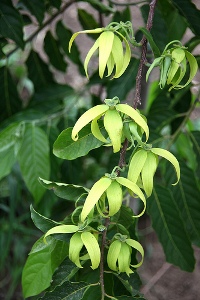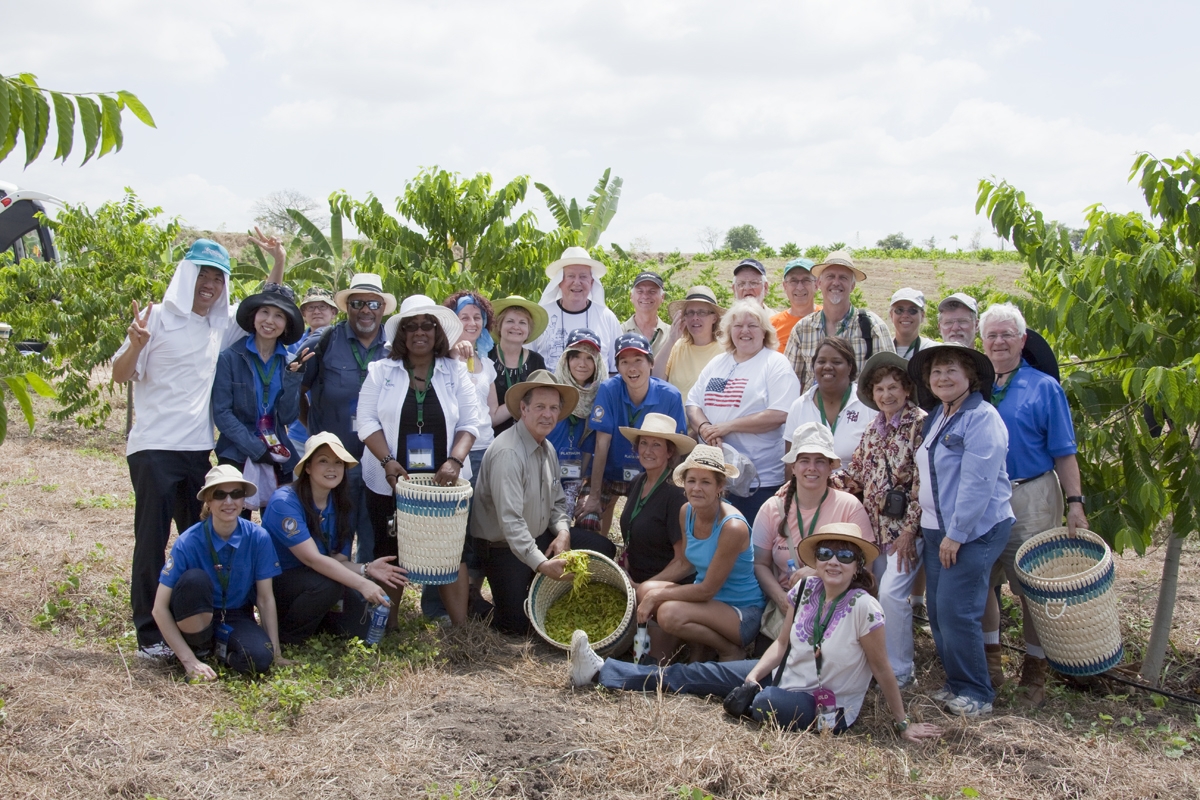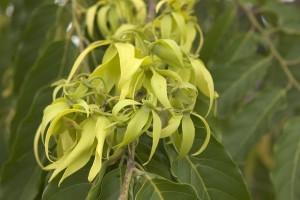Ylang Ylang—The “Flower of Flowers”
Editor’s Note: Since Gary Young’s passing, we have been taking stock of the tremendous contributions he made to the world by revisiting his presentations, such as this fascinating blog post series, originally published in 2011, that recounts Gary’s ylang ylang-growing journey.
Ylang ylang means “flower of flowers” and was named such because the tree has beautiful, fragrant flowers that are steam distilled to produce a powerful essential oil.

Ylang ylang blossoms
The oil is used in hair formulas, and is said to balance female-male energies, restore peace and positive thoughts, and as an aphrodisiac. It is also used for supporting normal blood pressure, easing minor motion sickness, and contains a host of other health-enhancing properties.
Ylang ylang originates from Madagascar and is being grown on the Young Living farm in Chongon (Guayaquil), Ecuador. In the Young Living ylang ylang groves, it’s harvest time again, although the main production time for ylang ylang runs from February to May.
During the Master Leader Retreat in June 2011, members had the opportunity to harvest ylang ylang flowers and plant new trees. They thoroughly enjoyed learning how to correctly harvest the flowers for the greatest yield and highest therapeutic value.
They learned that just as the monsoon rains start to end, the trees load up with water from the rain and put on flowers. The flowers then become very heavily laden with the water, which increases the glucose, or what we call the Brix, in the flower; and that all converts to essential oil, which is very exciting.

Gary and members on the farm in Ecuador.
Because of the beautiful fragrance, we have ylang ylang trees around our house and have our windows open at night to let in the breeze. On the farm a gentle breeze blows most of the time, and it’s most refreshing. It keeps the air clean and helps to move out the mosquitos during mosquito time.
But at night when it’s cool and that breeze blows in through the windows, the whole house fills with the fragrance of the ylang ylang flower, because the ylang ylang tree produces the most oil in the flowers during the nighttime and early morning, before the heat of the day.
WHEN SHOULD WE HARVEST YLANG YLANG?
Only if you grow, plant, harvest, and understand what is supposed to be in a plant can you produce the finest quality of oil with all its constituents. Anybody can print a GC (gas chromatograph), but to truly know the quality of oil, you must also understand how a GC and a MS (mass spectrometer) are operated and how to identify the compounds and the percentages of them.
However, there is more to it than that. You must know the best time of day to pick the leaves or flowers or harve

Gary Young tests the glucose levels of a plant.
t the entire plant from the field. In other words, you must know the best time of the day to harvest, when the Brix measurement of the glucose levels in the plant is the highest, to determine the best time to extract for the greatest quantity of essential oil.
For example, the best time to pick ylang ylang flowers, when the Brix measurement is the highest, is from midnight to 4 in the morning. But it is hard to get people to pick during that time. So we pick from daylight until 10 a.m., because we have found that the oil volume is maintained until about 10 o’clock, and then we will start losing some of the oil as it leaves the flowers and returns to the branches.
That is the reason why when we smell the flowers in the afternoon, the fragrance won’t be as intense, because the oil has gone back into the tree during the heat of the day to protect the tree from dehydration. Then at night as the temperature cools, the oil comes back up into the flower. It is very interesting to see how the tree preserves itself.
WHICH FLOWERS SHOULD WE PICK?
Because harvesting ylang ylang is all done by hand, it’s really important to know which flowers you should pick.

Gary Young touches the blossoms on a ylang ylang tree.
We want to pick flowers that have nice, long, yellow petals with perhaps a little green on them. If a flower is over-mature, it starts to shrivel, or atrophy, and smells sour. A flower that is still quite lime green is not mature enough to be picked.
Just like with other plants, it is in the harvesting and knowing the right time and the right flowers to pick.
With ylang ylang we generally consider the first four grades of flowers: extra fine, fine, first, and second. Sometimes we even have third and fourth qualifications, but the only ones that we’re concerned about are the first four grades.
So you can go from having a green, immature flower that is classified as a second grade to having a beautiful flower that is yellowish, mature, and rich in fragrance, which would be classified as an extra fine grade. The oxidized, over-mature flowers would likely be classified as first or second grade.
THE EXOTIC SMELL OF YLANG YLANG
Now how do we know when the flower is mature and right for picking? That is really important to know.
I teach my employees who work in the fields to pick the perfect, mature flower and smell it and smell it and smell it until they build a memory of the smell. Then I have them pick and smell a flower that is oxidized so that they can smell the difference. The oxidized flower has a sour note, almost like it is a little rancid. It still has a nice fragrance, but they can smell that faint sour note; it’s very mild, very little, but it’s there.
When other companies pay a picker by the kilo, they will get green, yellow, and oxidized, shriveling, brownish-yellow flowers. These will all go into the basket, because that picker wants to make as much volume as he can because that’s how he is paid. Unfortunately, in the commercial farms, that is what happens.
Now what makes that bad? When the flower starts to oxidize, the compounds start to hydrolyze, creating a sour smell that can affect the oil a little or a lot. The smell of ylang ylang is exquisite, and we don’t want anything less than that most exquisite smell.
Perhaps the majority of people wouldn’t know the difference, but it’s like eating an organic peach ripened on the tree or a non-organic peach picked slightly green and then left to ripen on the counter or in a box. The non-organic peach still tastes wonderful until you taste the organic, ripened peach from the tree. Then that is the only kind you want.
I remember when we first went to Ecuador and started eating the fresh mangos and bananas. We were amazed at how delicious they were, but prior to going to Ecuador, we didn’t know the difference.
WE PICK THE BEST FLOWERS AND LEAVE THE REST
Oil brokers who are just selling oils to the food and flavoring industries as well as the aromatherapy industry are not particular about the smell. Too often the smell is chemically enhanced, so who can be sure about getting a pure fragrance anyway?
Young Living is different. We want the purest, most beautiful smell possible. All of our workers are on our payroll and r

Blossoms from the exotic ylang ylang tree at YL’s Finca Botanica Aromatica farm in Chongon, Ecuador.
eceive a salary, so the problem of trying to “fill the basket” is eliminated. They are taught how to pick the best flowers and leave the rest.
Many of the members who were learning how to pick while visiting the farm had a hard time leaving the undesirable flowers because they were so nice to smell. But everyone understood and participated in the gathering of the very best, because that is important to Young Living.
We stand on quality and standards higher than any company in the world. I supervise all the growing and harvesting of our farms, which keeps me traveling all over the world.
In addition, I am fortunate to have such a great team of people in the office who have been with me for many years who protect our oil quality. Mary Lou Jacobson and Marc Schreuder have traveled to remote places of the world to inspect the facilities of others who produce for us to be certain that our oil quality is maintained. Dr. Cole Woolley, who joined Young Living as the Director of Research, has been overseeing our frankincense production in Oman and has been a great asset to me and our company.
I am very pleased to see in our office the commitment to maintaining the purity and high standards of our oils. As Young Living continues to grow and to develop farms, that standard will continue to be the mark of our company as we lead the world in the production and quality of therapeutic-grade essential oils.
Editor’s Note: The original 24,000 ylang ylang trees planted in 2011 continue to expand and by the end of 2019 will total 70,000 trees.


Would you like to share your thoughts?
Your email address will not be published. Required fields are marked *